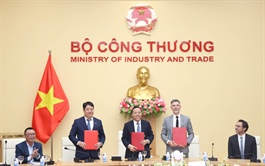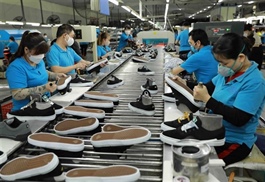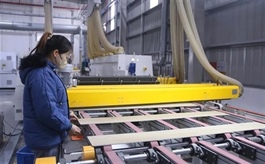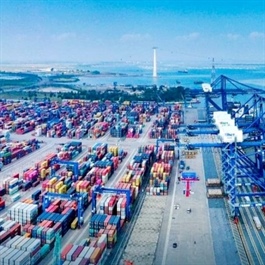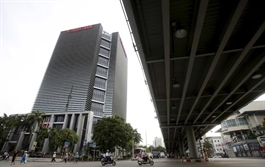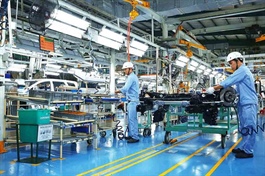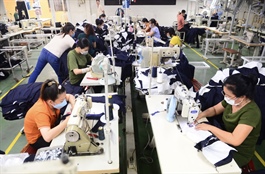Stimulating year ahead for pharma
Stimulating year ahead for pharma
Vietnam’s pharmaceutical market is expected to have a year of optimism after experiencing a multicoloured gamut in 2024.
In December, Traphaco kicked-off the second phase of tech transfer production, deemed an important milestone for industrial production and the launch of new products to the market.
Tran Tuc Ma, general director of Traphaco, emphasised, “Technology transfer is one of the company’s key tasks. The products transferred from Daewoong not only enhance the value of the western medicine group but also realise its strategy of building a high-quality medicine brand.”
In 2024, Traphaco, one of the five biggest domestic pharma firm in Vietnam, optimised its operational efficiency by carrying out digital transformation, making investment in research on new products, and strengthening research on high-quality oriental medicines and western drugs, generic medicines, bioequivalents, and those of technology transfer. It also evaluated the feasibility of investing in a GMP-EU factory in the northern province of Hung Yen.
In the short term, as shown in its latest third-quarter financial report, Traphaco’s consolidated revenue reached nearly $73 million, a slight increase from the same period last year, while its profit fell 37.85 per cent. The company blamed the drop on the fact that revenues of the over-the-counter (OTC) channel, which is the group’s main segment, did not meet the plan.
|
Many other major Vietnamese drugmakers also faced challenges last year. According to a survey released by Vietnam Report in late 2024, after a bright year in 2023, the growth momentum of the pharmaceutical, medical equipment, and healthcare industries slowed down in the first half of 2024. Accordingly, the market saw an on-year increase in the rate of businesses witnessing a business downturn.
The rate of businesses with declining profits also increased significantly, from 21.1 per cent to 37.5 per cent. Fluctuations in input material prices, increasingly fierce competition, and people’s tightened spending were the key reasons.
For Hau Giang Pharmaceutical (DHG), it made revenue of over $165 million in the first nine months of last year, up from over $163.33 million in the same period of 2023. Meanwhile, its after-tax profit fell 27.7 per cent on-year.
DHG invested in a factory meeting Japanese-GMP standards and put it into operation in the fourth quarter of 2024, with a total investment of $29.16 million, increasing its capacity by 25 per cent. Currently, its ethical drugs channel revenue accounts for about 11 per cent of DHG’s total revenue.
Sources of revenue
Elsewhere, Domesco Medical Import-Export Joint Stock Corporation witnessed an on-year rise of 0.7 per cent in net revenue in the January-September period to more than $18.6 million, but a fall of 26.5 per cent in after-tax profit.
Nguyen Duy Tung from Domesco blamed the situation on fiercer completion, and high exchange rate volatility and instability in some countries, leading to increased raw material and transportation costs.
While the drugmakers have not released full 2024 business results yet, experts said that they might make have good growth prospects thanks to the market’s recovery in the fourth quarter, which was typically a peak for businesses, especially those in the healthcare sector.
Dang Tran Phuc, chairman of the board of AzFin Vietnam, said, “Vietnamese pharmaceutical enterprises have sustainable growth, especially in the group of manufacturers when the demand for drugs in Vietnam has increased by 10 per cent each year.”
In 2024, DHG aimed for revenues of $216.66 million and pre-tax profit of $45 million, and ACB Securities Company forecasts that DHG may achieve higher results than planned. The pharmacy channel will continue to bring in the majority of revenue for the company, with antibiotics, pain relievers, and fever reducers still its key product groups.
Traphaco is also projected to have good growth results for 2024. It is the largest oriental medicine manufacturer in Vietnam, operating a GMP-certified medicinal herb factory and three WHO-certified manufacturing factories with 30,000 large customers in the market, including the Long Chau, Pharmacity, and An Khang chains.
For multinational corporations, growing partnerships with the Ministry of Health (MoH) and associations and medical facilities continued to be among their priorities last year in order to bring new pharmaceuticals and vaccines to Vietnam.
Specifically, AstraZeneca, thanks to its strong and comprehensive partnership with the Vietnamese government, the MoH, and various healthcare organisations, is implementing initiatives that address critical healthcare challenges and deliver tangible benefit to Vietnamese people, such as the Healthy Lung Programme, Young Health Programme, Health Innovation Network, and more.
Atul Tandon, AstraZeneca Vietnam general director, said, “We’re committed to transforming healthcare in Vietnam through innovative solutions. By partnering with the government, healthcare organisations, local experts, and investing in research and development, we’re developing innovative therapies that address unmet patient needs.”
Similarly, over the past decade, Novo Nordisk Vietnam has worked closely with the MoH and the Danish Embassy to Vietnam, hospital partners, and eminent associations like the Vietnam Association of Diabetes and Endocrinology to transform the treatment landscape. These partnerships have included developing physician capability building initiatives, raising public awareness, and shaping healthcare policy.
Future prospects 2025
Businesses are optimistic about the business outlook for 2025. According to a survey released by Vietnam Report in late 2024, two-thirds of pharmaceutical enterprises expressed confidence in the development of the market, while only 13 per cent were concerned about the challenges, and 20 per cent believe that the market will remain stable, with little volatility compared to last year.
Fitch Solutions forecasts that per capita spending on pharmaceuticals will increase significantly from $60.80 in 2021 to $88.30 in 2026, with a compound annual growth rate of 7.8 per cent.
Importantly, it added, new supporting policies in the amended Law on Pharmacy will also be a driving force for the development of the sector in the coming decades.
At present, related enterprises trend to not only focus on traditional products but are also expanding into new areas such as biopharmaceuticals, cancer treatment drugs, and rare drugs, driven by market trends and the government’s support policies.
The ethical drugs channel, which often dominates the industry’s revenue figures, is expected to maintain growth thanks to the universal health insurance policy, more relaxed and open hospital drug bidding regulations, and an increase in demand for specialised products, especially rare drugs and those for the treatment of serious diseases.
Meanwhile, the over-the-counter segment, although not seeing impressive revenue growth in the past 10 months, is also expected by most businesses to have more positive changes in 2025.
Senior pharma expert Le Van Truyen noted, “To truly make a breakthrough, the pharma, medical equipment, and healthcare industries need comprehensive efforts, not only to consolidate their domestic position but also to participate more deeply in the global value chain, contributing to enhancing international prestige and competitiveness, and positioning Vietnam on the global healthcare map.”
|
Erik Wiebols, general manager Novo Nordisk Vietnam
The revised Law on Pharmacy represents a significant effort by the Vietnamese government and National Assembly to modernise the country in this area. The changes in the law address long-standing industry concerns and create a foundation. It is crucial for the guiding regulations under the new law to be issued promptly to ensure clarity and avoid unnecessary administrative barriers. Member companies of the Pharma Group foresee the need for comprehensive capacity-building initiatives for both regulators and the industry. These efforts will be essential to effectively implement the ambitious objectives outlined in the law. While these changes are promising, there remains considerable work to enhance Vietnam’s competitiveness in the region. For example, attracting investment and fostering innovation will require continued policy refinement, particularly in comparison to other ASEAN countries. |







